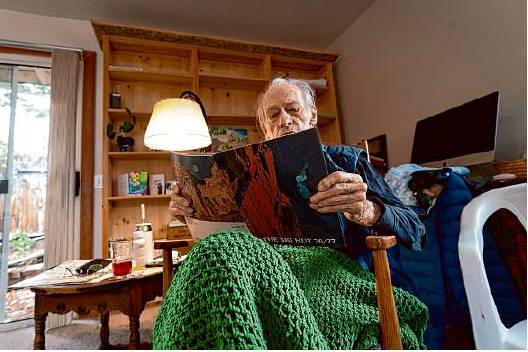Berkeley shop helped spur outdoor boom
By Kate Galbraith
A half-century ago, the magazine Field & Stream dubbed Berkeley “America’s backpacking capital.”
A big reason? A shop at 1615 University Ave. called the Ski Hut.
For nearly 40 years after its opening in 1935, the Ski Hut dominated the outdoor gear industry.
“It was command central for hiking, camping, skiing, canoeing, what else — snowshoe, backcountry and rock climbing, pitons and all,” said environmentalist Paul Hawken, who worked at the Ski Hut in the early 1960s.
The Ski Hut made some of its own gear, like tents, backpacks and sleeping bags. Customers also came for boot-fitting, for troubleshooting, and even to ask questions like what the weather would be like at Donner Pass over the weekend, recalls my aunt, Louise Dunlap, who worked part time at the Ski Hut from the mid-1950s to the mid-1960s.
“People came there for information, and they pretty much assumed if I worked there I knew the answer,” she said.
The Ski Hut was started by Stanford graduate George Rudolf and his skiing buddy Phillip Von Lublein. They invested $750 and began selling imported European ski gear in the teeth of the Great Depression.
The timing turned out to be excellent. Two years after the Ski Hut opened, the first major Sierra ski resort, Sugar Bowl, opened in 1937. Soon thereafter a railroad company began running ski trains that ferried Bay Area skiers to Donner Summit. Rudolf and Von Lublein lugged skis to the trains and rented them to riders.
The Ski Hut closed during World War II — both men joined the military. It reopened after the war, but Von Lublein became paralyzed in a ski accident, and ultimately Rudolf took sole charge of the business.
The 1950s were something of a heyday for mountain expeditions, with first technical ascents of El Capitan and Half Dome. Most Ski Hut employees were themselves climbers, hikers or skiers. Allen Steck, a manager there from 1952 to 1968, was a world-renowned climber whose feats included pioneering a route up the north face of Sentinel Rock in Yosemite in 1950. The route still bears the names of him and his climbing partner. Renowned Sierra climber and author Steve Roper spent winters in the 1960s and early 1970s fixing skis at the Ski Hut, while leaving other seasons free for climbing.
Through the 1960s, interest in the outdoors spread quickly to circles beyond the Sierra Club and alpine elite. More ski resorts opened, and interest in the environmental movement grew. Another factor in the rising interest, Steck said, was the Ski Hut itself: Its catalog allowed people to get their gear mail-ordered.
“Our catalog was going out all over the country,” Steck said.
Unusually from a modern standpoint, the Ski Hut had its own manufacturing line, called Trailwise — making it “America’s first outdoor retail outlet and manufacturing plant,” as Backpacker magazine dubbed it. Trailwise made gear including tents, pack frames and sleeping bags suited for mountain enthusiasts — lightweight and durable. Other products were imported from Europe.
“Best thing they ever did was make sleeping bags — beautiful down sleeping bags with baffling inside, which was pretty rare up to then,” Roper said. Baffles are divisions in the sleeping bag to hold the insulating material in place.
Steck, who managed Trail-wise and used his climber’s ingenuity to invent and perfect products, remembers the challenges of handling down.
“A big problem in sleeping bags is filling them with down,” he said. A down truck would roll up, and Steck and his colleagues would inspect it for quality. Then the contents would go into a down room — which was so dusty that the room needed a blower to keep the air clean, and people sometimes working with down had to wear masks. Measuring the quantity was important but extremely difficult, and Steck devised a new method. Getting the down into the sleeping bags, which often were sewed by women, was yet another difficulty.
In some ways, the Ski Hut may have helped plant the seeds of its own demise. It was where “many of the brains of the other Berkeley outfits went through basic training,” Field & Stream wrote in 1975.
Some former employees went on to found other notable Bay Area outdoor companies including Sierra Designs, Class 5 and Mountain Traders. Ken Klopp, a former president of the North Face, a Bay Area company until several years ago, also worked at the Ski Hut.
Losing employees “was a problem that we faced,” Steck, 96, recalled with a laugh. “But we got used to it, and they did a good job.”
As time went on, the Ski Hut faced more competition — and not just from its offshoots. REI — which was founded around the same time as the Ski Hut — opened a store in Berkeley in 1975. It was the cooperative’s first store outside Seattle.
Ultimately, Steck said, owner Rudolf suffered health problems and began to wind down the store. According to Field & Stream, Rudolf sold it to Saska Sports Industries of Brisbane in 1973. What happened after that is unclear, but an online historical plaque in Berkeley suggests an end date for the shop of 1978.
But in its heyday, the Ski Hut was the hub for a burgeoning industry. At its annual sale, “people would line up really early on the streets of University Avenue,” recalled Sara Steck, Allen’s daughter.
She and her friends would go out to dinner and then sleep on the street, she said — “so that we were the first to go in.”
Kate Galbraith is a San Francisco Chronicle staff writer. Email: kgalbraith@sfchronicle.com

